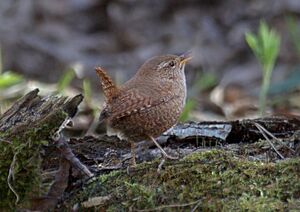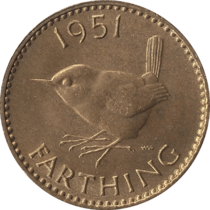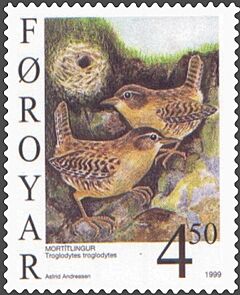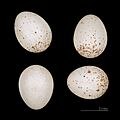Eurasian wren facts for kids
Quick facts for kids Eurasian wren |
|
|---|---|
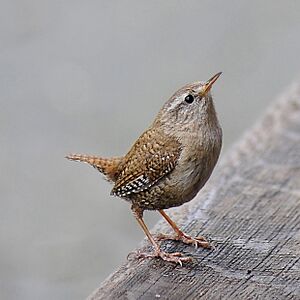 |
|
| Nominate subspecies in North Rhine-Westphalia, Germany | |
| Conservation status | |
| Scientific classification | |
 |
|
| Breeding summer visitor
Breeding resident Non-breeding winter visitor |
|
| Synonyms | |
|
The Eurasian wren (Troglodytes troglodytes) is a very small bird. It is also known as the northern wren. This bird eats mostly insects. It is the only member of the wren family found in Europe, Asia, and parts of Africa. In many European countries, people simply call it the "wren."
This tiny bird has a very short tail. It often holds its tail straight up. It also has a short neck and a thin beak. Its feathers are reddish-brown on top and lighter brown underneath. It has a creamy stripe above its eye. Male and female wrens look very similar.
The Eurasian wren lives across Europe and Asia, from Iran to Japan. Wrens in the northern parts of their range fly south for winter. This bird's scientific name, Troglodytes, comes from Greek words meaning "hole-dweller." This name fits because wrens often hide in small spaces when they hunt or rest.
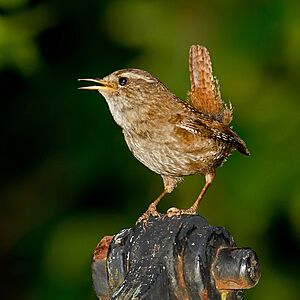
Contents
Understanding the Eurasian Wren
The Eurasian wren was first described in 1758 by Carl Linnaeus. He was a famous Swedish scientist. The name troglodytes means "cave-dweller" in Ancient Greek. This name was used because the wren often hides in small holes.
Scientists once thought the Eurasian wren was the same species as two wrens in North America. These were the winter wren and the Pacific wren. Now, they are known as separate species. There are 28 different types, or subspecies, of the Eurasian wren. For example, in Scotland, there are special wrens on islands like St Kilda and the Shetland Islands. These island wrens look a bit different from the wrens on the mainland.
What Does a Wren Look Like?
The Eurasian wren is a small, plump bird. It has rounded wings and a short tail that usually sticks up. An adult wren is about 9 to 10 centimeters (3.5 to 4 inches) long. Its wingspan is about 13 to 17 centimeters (5 to 6.5 inches). It weighs around 10 grams (0.35 ounces).
Its back is reddish-brown, and its belly is greyer. It has faint dark brown and grey stripes on its body, wings, and tail. Its beak is dark brown, and its legs are pale brown. Young wrens have less clear stripes. The color of their feathers can vary a lot depending on where they live.
Wren Sounds and Songs
The most common sound a wren makes is a sharp, quick "tic-tic-tic." When a wren is upset, it makes a loud "churr" sound. Its song is a fast burst of sweet, clear, and loud music. The male wren has a very long and complex song. It sings many trills one after another for several seconds.
This tiny bird has a surprisingly loud voice for its size. It is much louder than a chicken, for example. The song usually starts with a few notes, then goes into a trill, and ends with clear notes. You can hear its song in any season, but it is loudest in spring. Even though it acts like a mouse, the male wren might sing from a low branch. Its whole body shakes when it sings.
Where Wrens Live
The Eurasian wren lives across Europe and Asia. It can be found as far north as Norway and as far south as Spain and Italy. It also lives in parts of Western Asia. Different types of wrens live on islands like Iceland and the Faroe Islands.
Wrens live in many different places. They like areas with bushes and low plants. You can find them in gardens, hedges, and forests. They also live in open areas with thorny bushes, rocky coasts, and sea cliffs. They are very adaptable birds.
Wren Behavior and Habits
Wrens are always busy. They are constantly moving, looking for insects. They move with quick jerks, peeking into cracks and under logs. They usually stay close to the ground. Sometimes they hop up tree trunks like tiny nuthatches. When they fly, their short, round wings whir quickly.
This small bird is very common in Europe. It is often hard to spot because it moves so fast while hunting. Wrens can be found everywhere, from high mountains to the seashore. Even in winter, they stay in the uplands, hiding in thick plants when it snows. They also visit gardens and farms.
At night, especially in winter, wrens often sleep in dark, cozy spots. These can be holes or even old nests. When the weather is very cold, many wrens might gather together. They huddle in groups to keep warm.
Wren Reproduction and Nests
In most of Europe and Asia, wrens build their nests in coniferous forests. You can often hear their loud songs there. Even though they eat insects, they can stay in cold, snowy places. They find insects on tree bark and fallen logs.
The male wren builds several nests in his area. These are called "cock nests." The female chooses one of these nests. She prefers a male who has built many nests. The male will sing and show off his wings and tail during courtship.
The wren's nest is neatly shaped like a dome. It has an entrance on the side. Wrens build their nests from grass, moss, and leaves. They use whatever is nearby. Nests are often hidden in holes in walls or trees. They can also be in bushes, hedges, or even old nests of other birds. Once the female chooses a nest, she lines it with soft feathers.
Female wrens lay about five or six eggs, but sometimes as few as three or as many as eleven. They lay eggs starting in April. The eggs are white with reddish-brown spots. The female sits on the eggs for 14 to 15 days until they hatch. The young wrens eat insects, spiders, and other small creatures. The male helps feed the young after they leave the nest, which happens after about 16 days. Wrens usually have two groups of babies each year.
Male wrens can have more than one female with active nests at the same time. This means a male might have eggs or young in several nests. Having two or three females is common for wrens.
What Wrens Eat
Wrens mainly eat insects. Their diet includes caterpillars of butterflies and moths. They also eat beetle larvae, fly larvae, and aphids. Spiders are another important food source. Sometimes, they eat seeds too. Young wrens are mostly fed moth caterpillars and crane fly larvae.
Wrens and People
In old European stories, the wren is sometimes called the "king of the birds." One famous story, told by Aesop, says the wren rode on an eagle's back. When the eagle got tired, the wren flew higher, proving that being clever is better than being strong. In German, the wren is called Zaunkönig, which means "king of the fence." In Japan, it is called the "king of the winds."
The wren was a special bird to the Druids, who thought it was the "king of all birds." They used its songs to tell the future. Some people believed a wren's feather could protect them from bad luck.
The wren is also part of the legend of Saint Stephen. He was an early Christian martyr. The story says noisy wrens gave away his hiding spot. Because of this, on St. Stephen's Day (December 26th), there was a tradition called "Hunting the Wren." Young boys would catch a wren and parade it around town. This tradition is mentioned in an old song: "The Wren, the Wren, the king of all birds, St. Stephen's day was caught in the furze."
- In the book The Jungle Book by Rudyard Kipling, a wren named Limmershin tells the story of "The White Seal."
- Wrens have appeared on postage stamps from many countries, including Germany, Britain, and the United States.
- The wren is one of the animals in the Celtic zodiac.
- An old British coin, the farthing, had a wren on its back from 1937 to 1960. The wren was chosen because it was thought to be Britain's smallest bird.
Images for kids
-
A cuckoo egg in a wren's nest



